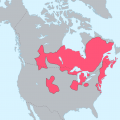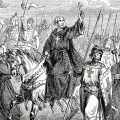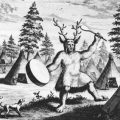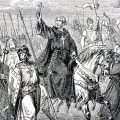Bands or tribes known collectively as the Apache ranged widely throughout the (American) Southwest at the time of the first Spanish exploration and invasion. The Apache are Athabascan-speaking and migrated into the Southwest from Canada perhaps as early as 850 CE, but most likely between the late 1200s and early 1400s. In her entry on the Western Apache in the Encyclopedia of North American Indians, Elizabeth Brandt writes:
“Evidence from archaeological sites suggests a date around A.D. 1450 for the entry of Athabaskan peoples into the Southwest, but some scholars call for earlier dates.”
There is no single Apache tribe or nation. In general, there are six major divisions of the Apache: the Western Apache, Chiricahua, Mescalero, Jicarilla, Lipan, and Kiowa-Apache. The Western Apache include five groups: Cibecue, San Carlos, White Mountain, Northern Tonto, and Southern Tonto.
There are several functions of spiritual power among the Apache: (1) spiritual power provides the individual with general protection, (2) spiritual power sometimes provides the ability to cure a specific disease, and (3) spiritual power can bring success in daily activities, such as love, hunting, warfare, and gambling.
Among the Western Apache, spiritual power is important. They feel that there is an inexhaustible supply of power in the universe and that each person can bring a little of this power under their control. Most of the power, however, is free to act on its own. This power, according to anthropologist Keith Basso, in his book The Cibecue Apache:
“does not possess moral sanctity, nor is it considered by Apaches to be inherently benevolent. To the contrary, if a power is offended by what it considers disrespectful behavior it is capable of causing hardship.”
The best way not to offend a power is to extend to it the same courtesies given to human beings.
Historian Robert Utley, in his book A Clash of Cultures: Fort Bowie and the Chiricahua Apaches, writes of Chiricahua Apache religion:
“Religion helped one to acquire the supernatural power needed for guidance and assistance throughout life. Religion placated or nullified the evil forces that caused disease and calamity; it helped to ensure success in war.”
Power among the Western Apache may be acquired in two ways: (1) the power finds you, and (2) you find the power. In the first instance, power may come to people in dreams or it may come to them when they are awake. An unusual or unexpected event may indicate that the power is near and is prepared to make itself available to the person. Songs which come to people in dreams provide direct knowledge of spiritual power.
In the second way of finding a power – you find the power – the individual learns the appropriate chants and prayers to the power. If done correctly, the power will start working for the individual.
Each power has a series of chants and prayers associated with it. To acquire the chants, the person must pay for them. In addition to paying the instructor, the student must also support himself and his teacher during the period of instruction. There are often 55-60 different chants for a particular power, such as Blacktailed Deer Power. Each chant has as many as 26 different verses and may take up to half an hour to sing. Each chant must be performed without error or deviation. In addition, anthropologist Keith Basso points out:
“Chants are not easy to sing. They are apt to range over more than one octave and sometimes involve abrupt and difficult changes in pitch and tempo.”
The four cardinal directions – east, south, west, and north – are associated with spiritual powers, and of these, east is considered to be most holy. For this reason, the spiritual leaders, singers, and drummers will often face east during ceremonies.
Some Apache individuals have greater access to spiritual power than others. These people are commonly known as medicine men and medicine women.
Among the Apache, the power may occasionally instruct the medicine man to create a deer hide painting. According to Cécile R. Ganteaume, in an article in American Indian Art:
“Unlike some men who used their power for personal benefit, the men who made deer hide paintings used their power for the benefit of the community.”
The images in the painting may show holy powers such as thunder or lightning. Hummingbirds, the supernatural messengers who carry Apache prayers to the spiritual realm, are often shown in the deer hide paintings.





Leave a Reply